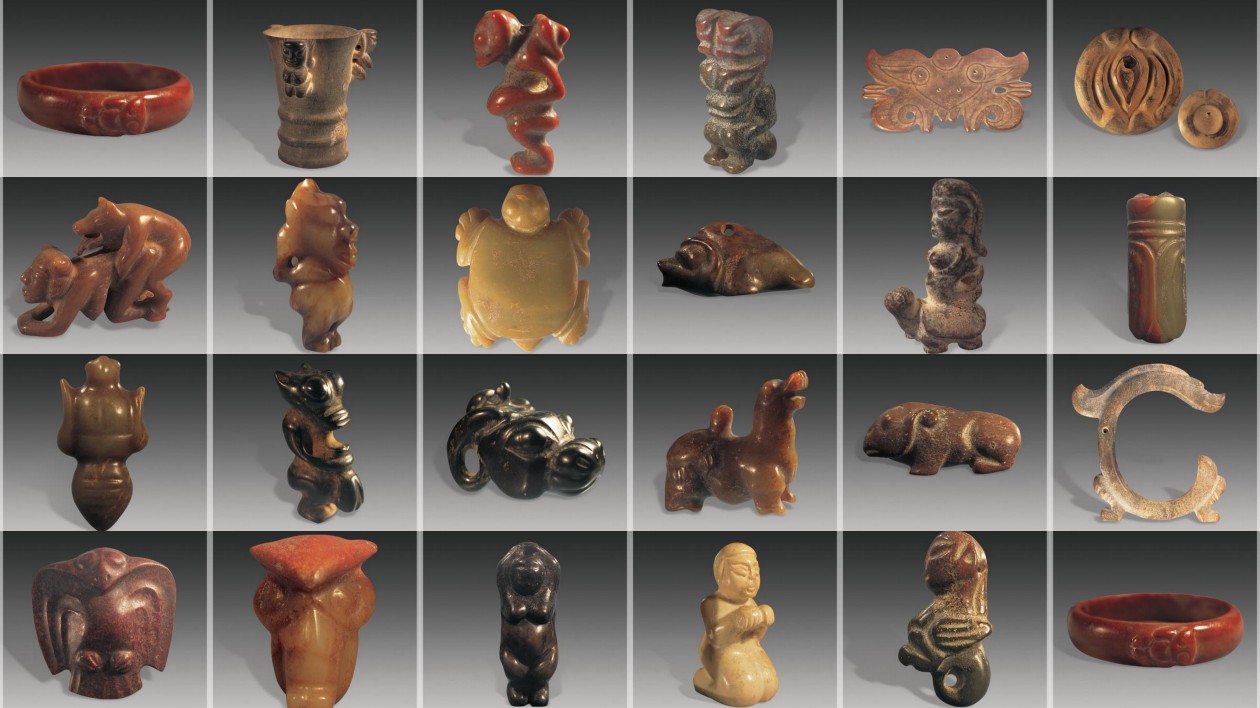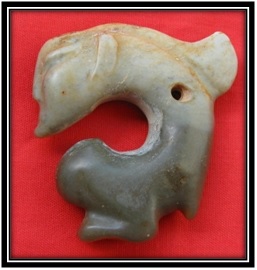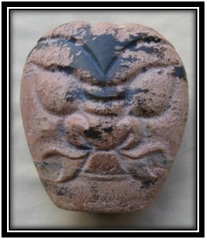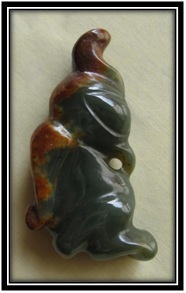氏族图腾造像
氏族的图腾崇拜是氏族宗教的重要内容。泛红山文化时期是一个繁荣的氏族社会,泛红山文化玉群中有多种氏族图腾的造像,他们的造型是上古传说的生动写照,是《山海经》等远古经典传说的形象注释,同时也证实了很多远古的传说是有其真实的历史背景的。很多传说中的中华祖先的图腾形象在泛红山文化玉群中可以看到他们的生动造型。由此也可证实泛红山文化是中华文明的重要源头。
Clan Totem Statues
Clan totem worship was an important part of the original clan religion. It is a prosperous community during the Pan-Hongshan cultural period, there are many kinds of clan totem statues among the Pan-Hongshan cultural jade group. They are vivid portrayals of ancient legends, also they are the image annotations of the ancient classics, such as <Shan Hai Jing>, and they confirmed that many ancient legends have their true historical background. Many vivid totem images of legendary Chinese ancestors can be seen among the Pan-Hongshan cultural jade group. These totem images also confirmed that the Pan-Hongshan culture is an important source of Chinese civilization.
—
Fig 1.6
1.6 人首夔龙—雷神
高5.2cm,宽5.5cm,厚1.5cm。
青玉,鸡骨白沁色,有灰皮、蚀斑及蚀孔。
其造型为一人与带翅翼龙之融合体,人首、人足、龙身和鸟翅。整体造型是与三星他拉“ C ”形龙为基础,将其头换为人头,并且在其背部加翼,在其尾部加足。其头部形象为:一双吊梢细目突起,鼻梁挺拔直通上额,双耳贴于面颊后,小嘴呈“ 一 ”字形,尖下颌前翘,颈后有鬣,鬣端上翘。背部有下垂的翅膀,近尾端处生有一双人脚,背部中间有一对钻圆孔。这一造型像是传说中雷神的形象,他可兼控海、陆、空,既可呼风唤雨又可翻江倒海、雷霆万钧,威力无比。传说伏羲之母华胥就是因为踏到了雷神的大足印迹而怀孕,生出人首龙身的伏羲。伏羲是中华民族的共同祖先,人首龙身或人首蛇身是他的图腾形象。
1.6. Thunder God in human head and dragon body shape
High: 5.2cm, width: 5.5cm, thickness: 1.5cm.
The jade is sapphire with corrosive pits and holes and white markings on the surface.
It’s a human and a dragon integrated statue. Its shape is: human head and feet, C-shaped dragon body with wings, a long mane behind the neck. There is a perforation on its back. This statue is the Thunder God image in legend. It is a super-powerful god; it can control the land, sea and sky. There was a legend that Fuxi’s mother “Huaxu” once stepped on a large foot point of the Thunder God, and then she was pregnant and gave birth to Fuxi who has human head and dragon body. Fuxi is the common ancestor of the Chinese nation; his totemic image is in human head and dragon or snake body.
—
Fig 1.7
1.7 蛙神女娲
高6.4cm,宽2.5cm,厚2.3cm。
灰绿玉,有灰皮、蚀斑及蚀孔。背面沁色厚重,呈棕、红等色。
其造型为一跪姿女子,身体直立,面朝前,眉目清秀,吊梢眼突起,鼻梁较宽,口微张,一双大耳贴于面颊后侧;双乳高突,双手托于双乳下方;头顶一蛙,蛙之双目向两侧突起;前腿直立,后腿屈蹲,似欲跃起之状,形态生动,且蛙呈黄色,可谓巧沁。此造像是哺乳期母亲的形象,应是蛙氏族母祖之像,有祖先崇拜的寓意。自泛红山文化早期至新石器时期,蛙是相当普遍的氏族图腾。蛙与娲相通,传说中也有女娲为娲神之说,故此女子之造像实为女娲之像。传说伏羲和女娲是夫妻,他们是中华民族的共同祖先,正像是西方传说中的亚当和夏娃一样。除了人形的女娲造像外,还有蛙形的女娲图腾造像,蛙首人身的女娲氏族造像以及她的人首蛇身的图腾造像等。
1.7. The Frog Goddess Nuwa
High: 6.4cm, width: 2.5cm, thickness: 2.3cm.
The jade is in gray-green color and reddish-brown markings.
The statue is a woman in kneeling posture, facing front, her upper body is upright, and her eyes are sloping upward, mouth slightly open, ears affixed to the back of the cheek. She has a pair of high convex breasts, and put her hands at the bottom of breasts. There is a frog on her top of head, it has high convex eyes, upright front legs and squatting back legs, it is a vivid frog’s image. This woman looks like an image of nursing mother; the frog decoration means that she is ancestress of the Frog clan. Since the Pan-Hongshan cultural period to the Neolithic period, the frog was a very common clan’s totem. A historical legend said that the human ancestress Nuwa was a Frog Goddess, so this image should be the statue of the Goddess Nuw a. In addition according to the legend, Fuxi and Nuwa are husband and wife; they are the common ancestors of Chinese nation, just as is the Western legend of the Adam and Eve. Apart from Nuwa statues in human form, there are frog-shaped Nuwa totemic statues, the frog head and human body Nuwa clan totemic statues, the human head and snake body Nuwa totemic statues and so on.
—
Fig 1.8
1.8 有熊氏图腾
高7cm,宽3cm,厚3.2cm。
全器呈鸡骨白沁色,原玉质不辨。
其造型为一人、熊融合体,上半身为熊体,腰部以下为人体。他的双目圆突,鼻梁很高,尖鼻,双耳未饰出,背部隆起,双手托在胸前一对乳房下面,双腿屈蹲立于地面。背后有一对钻牛鼻穿。他应是母系社会有熊氏族的图腾造像,亦即黄帝氏族图腾造像,他表明黄帝氏族曾以狩猎为主要谋生手段,黄帝氏族又以天鼋即大海龟为图腾,表明该氏族又以海上捕鱼为生。综合上述可知黄帝氏族曾是以渔、猎为主的氏族。
1.8. Bear clan’s totem
High: 7cm, width: 3cm, thickness: 3.2cm.
The jade is covered by chicken bone colored skin.
It is a statue of a standing woman with bear head. Its shape is round convex eyes, high nose, bulgy back, and squatting legs; her hands hold her breasts. There is an ox-nostril shaped hole on the back. It is a statue of bear clan’s totem in matriarchal society. The bear clan was the predecessor of the Huangdi family, so Huangdi clan took bear as its clan’s totem, and known as ‘Youxiong’; the Huangdi clan also known as ‘Xuanyuan’ and took sea turtle for its totem. It can be known that the predecessor of Huangdi clan had been a united clan of the bear clan and the sea turtle clan, that is the coalition of a hunting clan and a fishing clan.
—
Fig 1.9
1.9 天鼋氏图腾
高6.8cm,宽2.8cm,厚2.6cm。
青玉,鸡骨白沁色。
其形为一立姿鼋首,鼋背神人。头略仰,水滴形双目突出,鼻上翘,闭口。身体两侧有双臂,背部有长圆形壳,双腿并拢微屈。从头顶至足跟有一对钻直孔。黄帝氏族是以鼋为图腾的氏族,轩辕即天鼋,是一种大海龟,这件玉饰即为黄帝氏族的图腾像。由此可知,早期的黄帝氏族的一部分曾是海上的渔民。
1.9. Turtle clan’s totem
High: 6.8cm, width: 2.8cm, thickness: 2.6cm.
The jade is sapphire and part of the surface covered by chicken-bone color.
The modeling is a totem with turtle head, turtle shell and human body. It shape is: head upward ,the drop-shaped eyes high convex, upturned nose, closed mouth, arms affixed to the sides, an oval-shaped turtle shell on the back, feet closer together. There is a straight bifacial drilling hole from the bottom to the top. The turtle is one of the totems of the Yellow Emperor’s family; a part of original Yellow Emperor clan was a family of fishermen at sea.
—
Fig 1.10
1.10 牛氏族图腾
高17.3cm,宽5.8cm,厚7.8cm。
青玉,棕、红沁色,有蚀斑、蚀孔。蚀孔中有再生晶粒镶
坎其中,表面有很多定向结晶斑,阳光或灯光下显出银色
闪光。
其造型为一牛首女人身体之神人。牛首形为双目呈水滴状
突起,半圆形大耳伸向脑后,鼻口部前噘,翻鼻孔,口未
饰出。头上有二角伸向脑后,角之尖端上翘。女人身形为
双腿呈跪式,双手置于膝上,臀部发达,向后拢起。一双
大乳垂于胸前,是典型哺乳期女体的形象。故此神像是一
位女神像。传说炎帝牛首人身,故此神像应是炎帝氏族母
祖之造像,亦即其氏族图腾像。此造像背面颈后有一对钻
牛鼻穿。
1.10. Ox clan totem
High: 17.3cm, width: 5.8cm, thickness: 7.8cm.
The jade is sapphire with reddish-brown markings and corrosive stripes and holes, and some visible regenerate crystal particles in the corrosive holes.
It is an ox head and human body goddess in kneeling position. Its shape is: high convex drop-shaped eyes, semi-circular shaped ears, muzzle protruding forward, nostrils upturned, two horns stretched to behind of the head and the horn tips bending upward, a pair of large breasts hanging on chest, and buttock uplift. According to the historical legend the image of Yandi was ox head and human body, so the statue should be the ancestress of the Yandi family that is the totem of Yandi family. There is an ox-nostril shaped hole at the back of the statue.
—
Fig 1.11 Fig 1.11
1.11 人、鹰双面饰
高12cm,宽10.5cm,厚7cm。
青绿玉,棕色沁色。
其造型为一双面雕玉饰。一面是人像,水滴状吊梢大眼,蒜头鼻,鼻孔外翻,大嘴,犬齿外露,齿尖锐利,舌外伸向上舔到鼻端,两眉直插发际。造型端庄威严,外轮廓形似苹果,上宽下窄,应是凿齿氏族祖先像。背面为一立姿雌鹰,大头,水滴状大目突起,大嘴,尖端内钩,腹部隆起,胸前有一对大乳房,双腿健壮,屈蹲状。两侧有双翅,整体造型十分健美、端庄。这件双面玉饰艺术性与工艺水平都很高。其含意应是以鹰为图腾的凿齿氏祖先像。凿齿氏是东夷太昊族的一个分支,他们的分布很广,他们对中华文明的创建有很大贡献。
1.11. Double-sided sculpture of portrait and eagle
High: 12cm, width: 10.5cm, thickness: 7cm.
The jade is in green color and brown markings.
One side of the ornament is a portrait; its shape is drop-shaped slope up eyes, garlic-shaped nose, and upturned nostrils, large mouth, sharp canines exposed, tongue stretched upward, eyebrows stretched up to hair line. The overall shape is in dignified and majestic style. This is the leader image of Zaochi clan. The other side is a standing eagle. Its shape is: big eyes, big beak with hook-shaped tip, bulged abdomen, chest with a pair of breasts, legs squatting, and wings affixed both sides. The eagle shape is beautiful and fitness. It shows that the eagle is a totem of Zaochi clan which is a branch of East Yi nationality. They had wildly distribution; and had great contribution for creating Chinese civilization. This jade sculpture is in very high artistic and technology level.
—
Fig 1.12
1.12 鸟人
高6.4厘米,最宽3.2厘米,厚1.7厘米。
翠绿玉,棕红沁色,玻璃光泽。
造型为一蹲姿鸟人,其形为:水滴状大目高凸,尖喙内钩,头顶生一前翘的羽冠。两臂贴于身体后侧,背手,鼓腹,双腿屈蹲,鸟足,爪趾内钩。此鸟人玉质极佳,造型生动,工艺高超。鸟人即“山海经。海外南经”中所说的“鹳头国”的图腾造型。如今南太平洋地区的复活节岛等地,仍尊奉鸟人。距今一万五千年左右,鹳头氏族活跃于中国的东北,他们可能是最早的文字的创造者。
1.12. Bird man
High: 6.4cm, width: 3.2cm, thickness: 1.7cm.
The jade is in green color, glass luster and brown markings.
It is a totemic statue with bird head, bird feet and human body. Its shape is: drop-shaped high convex eyes, hook-shaped beak, and a crest on head, two hands at the back, the abdomen bulged, and legs squatting. This is a vivid image and superb technique.
The Bird man is the totem of the “Stork Head State” recorded in < Shanhai jing> classics. Today some people still enshrine Bird man, such as Easter Island and other places in South Pacific area. Dating back 15000 years or so, the Stork Head clan flourished in Northeast China, they maybe the founder of the earliest writing system.
—
Fig 1.13
1.13 羽蛇神
高6.8cm,宽 3.8cm,厚 1.8cm。
熊胆青玉,棕红沁色。
这是一件人首、翼龙体女神像。人首形为双目突出,眼角上挑,直鼻,大口,双耳贴于侧后方,倒竖。长发披于背后。身体似夔龙,胸前有弯曲状前肢,龙尾内卷呈环形,背后有双翅。脑后有一对钻牛鼻穿。
此造像很像玛雅文化传说中的羽蛇神奎扎科特尔,它也与图1.6所示的雷神形状相似。
1.13. The Feathered Serpent God
High: 6.8cm, width: 3.8cm, thickness: 1.8cm.
The jade is in dark green color and reddish brown stains on the surface.
This statue is a goddess image. She has woman head and dragon body; and there are a pair of wings and a pair of feet on her body, and an ox nostril-shaped hole behind her head. This statue is much like the legendary Feathered Serpent God-Quetzalcoatl in Mayan culture,her image is similar to the thunder god showed on figure 1.6.
—














